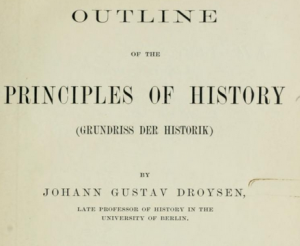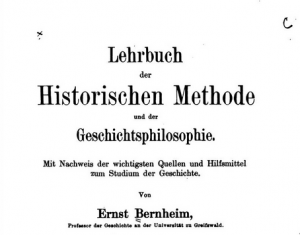Provenance Meets Source Criticism
Katharina Hering
(This is a slightly revised version of the paper from which I spoke at the AHA. I added links, references, a few images, and an introductory paragraph. I also changed the title.)
Archival and historical theory and methodology emerged in the late 19th century in a related historical and disciplinary context. Yet, to the degree that archives and history have evolved as separate disciplines and professional fields,[1] they tend to be treated as separate traditions. As Joshua Sternfeld and the other panelists have emphasized, however, critical digital historiography brings together elements of both archival and historical theory and methodology. The archival principle of provenance and the historical tradition of source criticism, in particular, complement another in underscoring the importance of providing context for documents, records, collections, archives, and digital historical representations.
Traditionally, the archival concept of provenance refers “to the individual, family, or organization that created or received the items in a collection,” and the principle of provenance suggests that records originating from the same source should be kept together, and should not be interfiled with records from other sources to preserve their context.[2] The Canadian archivist Laura Millar emphasizes the importance of recognizing provenance as the key element of archival arrangement and description.[3] At the same time, Millar argues for an expanded understanding of provenance as a combination of creator history, records history, and custodial history. Her broadened concept of archival provenance is based on a comparative analysis of the concepts of provenance in museology, archaeology, and in archives, all of which have slightly different traditions and meanings. Millar further argues that a respect de provenance offers a more useful and realistic basis for a broader contextualization of records than the principle of the respect des fonds,[4] which has traditionally shaped descriptive practice, especially in government archives.

Example from the 5.1 DACS custodial history field, DACS, A Content Standard, 2nd edition, online at the SAA website.
While emphasizing the importance of provenance as a key archival principle, Millar—among others—acknowledges that there is a discrepancy between aspiration and practice: While archivists generally agree that providing information about the provenance of records and collections is critical, this understanding is not always reflected by archival practices. While many archives and archivists make an effort to provide detailed information about the provenance of specific records or collections, the fields in archival finding aids, or in catalog records, where information about provenance is supplied, often remain sparsely populated, or empty.[5] In absence of a systematic study of existing attitudes and practices, the reasons for this remain speculative. It may be because information about provenance is not considered relevant enough, or because this contextual information is not available, or because it was not transferred from institutional documentation to finding aids. Whether or not users care about this information is another, related question, which sparked an interesting discussion on Archives Next in 2012 – the consensus seem to have been: it depends.[6]
The lack of information about the provenance of collections, or individual items, is exacerbated in digital archives and collections, or collections of digital historical representations. As Joshua Sternfeld has highlighted, items that become part of digital collections can easily get detached from their original collection context, and in that process, existing information about the original provenance of the item frequently gets lost. This can also happen with digital collections that are removed from their original creation context. Just as in many physical archives, the contextual information about the provenance of digital collections, or digital objects that are part of digital collections, may not have been collected in the first place. Supplying information about provenance in digital archives is also more complicated due to the massive scale of many collections, and due to the fact that one has to distinguish between the provenance of the original record, item, or collection (if it was a physical object that has been digitized), and the provenance of the digital historical representation, or collection of digital historical representations. Thus, digital collections often require additional layers of information about provenance.
The reasons for the lack of adequate contextual information about provenance of digital historical representations are complex, and there are many challenges to providing this information or metadata – technical, conceptual, institutional, and economical. These challenges, however, do not diminish the importance and the ethical obligation for providing adequate contextual information about items, collections, or digital historical representations. “Is it ethical for archivists to detach digital items from their archival context in order to make them more ‘digital friendly’ and more accessible to meet needs of some users?” Jane Zhang asks.[7]
I believe that the tradition of source criticism in historical theory and methodology complements the archival principle of provenance, and that it adds an important historical perspective to the archival obligation to provide information about the provenance of digital historical representations. Source criticism has been an integral part of historical theory and method since the concept was introduced by Prussian historian and philosopher Johann Gustav Droysen, and then further developed by historical theorist and philosopher Ernst Bernheim.
Droysen in his Outline of the Principles of History (1st German edition in 1867, first English ed. in 1893) defined the task of criticism as to “determine what relation the materials still before us bears to the acts of will whereof it testifies.”[8] Droysen distinguished several elements of criticism: criticism determines the genuineness and authenticity of a source, it addresses the development from earlier to later forms of the materials, it questions the validity of the information and the source, and the correctness of the information. Source criticism also includes the critical analysis of the information in the source itself: which events and developments does it reflect, how was the description influenced by its contemporary context, who was the author, how did it relate to other sources of the time?[9] Droysen emphasized that the outcome of the critical analysis was not the “exact historical fact,” but rather the ability to place “the materials in such a condition as renders possible a relatively safe and correct judgment.”[10] Historian and philosopher Ernst Bernheim later expanded and specified Droysen’s theory. [11]
Especially relevant in this context is Bernheim’s distinction between internal and external source criticism – the critical analysis of the content of the source versus the analysis of the creation context or provenance of the source. Based on Laura Millar’s definition of provenance, one could also understand external source criticism – when applied to individual records as well as collections — as the investigation of creator history, records history, and custodial history.
Certainly, the tradition of source criticism has to be situated in its time and historical context in the late 19th century, and the notion of a “source” itself can be problematic, as Michael Kramer highlights in his perceptive criticism of the essentialist connotation of a “source” as something that can be exploited by the historian (see Michael Kramer, “Going Meta on Metadata”). Still, the tradition of source criticism and the archival principle of provenance complement another in highlighting the importance of collecting and providing contextual information for sources or collections. Combined with a broadened understanding of provenance, the tradition of source criticism can support archivists, historians, librarians, digital humanists, and others with developing a set of questions and a vocabulary that can aid the analysis and description of digital collections, or digital historical representations alike. Digital source and resource criticism—in a revised, modern version, which was developed and theorized by the late Swiss historian Peter Haber[12]—as well as provenance are important elements of critical digital historiography.
But how can such an ambitious goal, framed by archival and historical theory, be implemented? What are the challenges at specific institutions? What are possible practical approaches for archivists, historians, librarians, and others to collaborate to collect and provide adequate, critical, contextual information about digital historical representations? How can contextual information that historians gather in the course of their research make their way into archival finding aids or catalog records? How can the contextual knowledge about collections that archivists have gathered help historians with developing source critical analyses? What can researchers and archivists do if they find that digital historical representations lack adequate contextual information? How can source criticism lead to resource and database criticism? How can information professionals, including archivists, and researchers, including historians, voice their concerns when faced with a lack of contextual information provided by big commercial databases, such as JSTOR, Ancestry.com, EBSCO, and, of course, Google, over which they have no control? How can collaborative teams of history liaison librarians, archivists, and historians develop portals that help with supplying contextual information about the provenance of specific collections made available by commercial databases that allow a critical, informed use of these resources?[13]
When confronting these complex questions, the principle of provenance and the tradition of source criticism can provide a familiar basis for historians and archivists, while serving as guides for developing new, collaborative models of providing archival and historical context for digital surrogates.
Originally published by Katharina Hering on January 20, 2014. Revised for Journal of Digital Humanities August 2014.
- [1]Robert Townsend, History’s Babel: Scholarship, Professionalization, and the Historical Enterprise in the United States, 1880-1940. Chicago; London: University of Chicago Press, 2013.↩
- [2]See the definition of provenance in SAA’s online glossary of archival and records terminology. Last visited: July 15, 2014.↩
- [3]Laura Millar, “The Death of the Fonds and the Resurrection of Provenance: Archival Context in Space and Time,” Archivaria 53 (Spring 2002): 1-15.↩
- [4]See the definition of fonds in SAA’s online glossary of archival and records terminology. Last visited: July 15, 2014.↩
- [5]Depending on the content and cataloging standards used, the relevant fields differ. In APPM, which was replaced by DACS, existed a field for information about provenance. In DACS, the relevant fields to include information about provenance are administrative/biographical history; custodial history, and immediate source of acquisition, in ISAD (G), the field for custodial history is called archival history. Related and relevant MARC fields are 541, 545 and 561. Provenance is not one of the 15 elements of the simple Dublin Core metadata element set, but part of qualified Dublin Core. Thanks to Kate Theimer for suggesting the clarification regarding the relevant fields.↩
- [6]See: Kate Theimer, “Debate: The majority of users don’t care about provenance. They just want access to information,” Archives Next, May 2012. Last visited: July 20, 2014.↩
- [7]See Jane Zhang’s reference to her 2012 paper on Archival Context, Digital Content, and the Ethics of Digital Archival Representation in the 2012 discussion about provenance in Archives Next.↩
- [8]Johann Gustav Droysen, <em>Outline of the Principles of History (Grundriss der Historik)</em>. Translated by E. Benjamin Andrews. New York: Howard Fertig Inc. edition, 1967. Originally published in English in 1893. German original published in 1867, p. 20. 1893 edition available from the Internet Archive. Last visited July 30, 2014.↩
- [9]Droysen, Outline, ibid., paragraph 26-36, pp. 21-26.↩
- [10]Droysen, ibid.↩
- [11]Ernst Bernheim, Lehrbuch der historischen Methode und der Geschichtsphilosophie, 1st German ed. 1889. Bernheim’s Lehrbuch was never translated into English. The 5th and 6th 1908 Leipzig edition is available from the Internet Archive.↩
- [12]See: Peter Haber, Digital Past, München: Oldenbourg 2011, among other publications.↩
- [13]Beyond Citation, a very interesting project exactly along these lines that ”seeks to encourage critical thinking about academic databases and their impact on research and scholarship,” has recently been developed as part of the Digital Praxis seminar at CUNY. See Eileen Clancy’s Feb. 10, 2014 comment on our blog posts.↩


